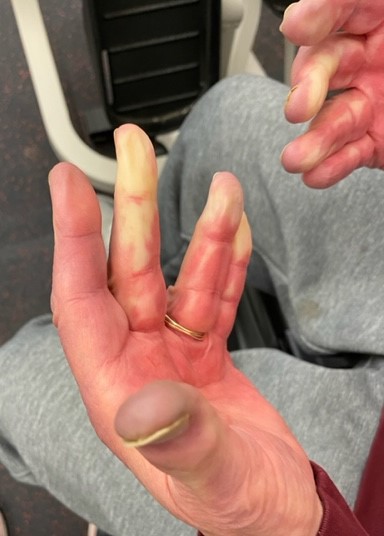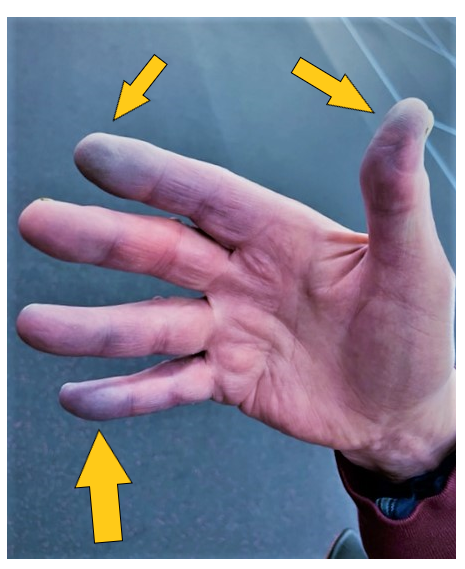
The picture above is of my client who has Parkinson’s. He kept coming into the gym wondering why his hands were purple. This is what Raynaud’s Syndrome/Phenomenon can look like.
Raynaud’s is a decrease in blood flow mainly in the fingers, but it can also affect the nose, ears, or toes. Raynaud’s affects three to five percent of people in the United States. Women are more likely to have Raynaud’s. I have Raynaud’s myself, so I know how painful it can be when you aren’t moving your hands a lot!
Raynaud’s is more common in people who live in colder climates. It affects a wide range of people, including those with autoimmune diseases like lupus, scleroderma, and rheumatoid arthritis. Smoking cigarettes, certain medications, injuries, thyroid and blood disorders, and family history are also risk factors.
The primary symptom of Raynaud’s is the skin on the affected area turning white, then blue or purple, with numbness. When the hands are eventually warmed, it can be extremely painful with swelling and redness. Cold climate or emotional stress can cause a flare-up.

There is no cure for Raynaud’s, but there are tools for management, such as keeping the hands and feet warm, avoiding your skin being exposed to cold, medication for reducing blood vessel constriction, and—most importantly—movement!
While Parkinson’s is not linked as a cause of Raynaud’s, it is possible to have both, like my client in the photos. A very prevalent symptom of PD includes autonomic dysfunction. This affects the nervous system with functions like heart rate, sweat glands, and blood vessels. This exaggerates Raynaud’s, making it more difficult to encourage blood flow to the extremities. People with Parkinson’s also tend to move their hands less frequently and with less intensity. The key to keeping blood flowing to your hands is making bigger, more frequent movements with greater intensity.
Whether you have Parkinson’s or Raynaud’s or both, it’s essential that you keep your hands moving. I developed my hand exercise course so that you could have daily exercises to help relieve stiffness, improve dexterity, and increase blood flow in your hands and fingers. These short, effective videos make it easy to incorporate hand exercises into your daily routine. The amount of improvement seen when you do these movements every day is amazing.
Click here to get my daily course of hand exercises. It will give you the tools you need to get your hands moving better!

Ready to take back your fight?
Contact me to get started in Kimberly Berg’s Rebel Fit Club Parkinson’s Boxing classes today. We have online workouts, too!
Subscribe now to get more tips and exercises for Parkinson’s delivered right to your inbox!